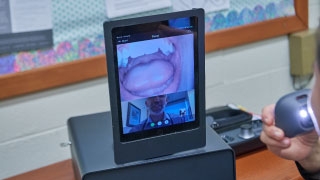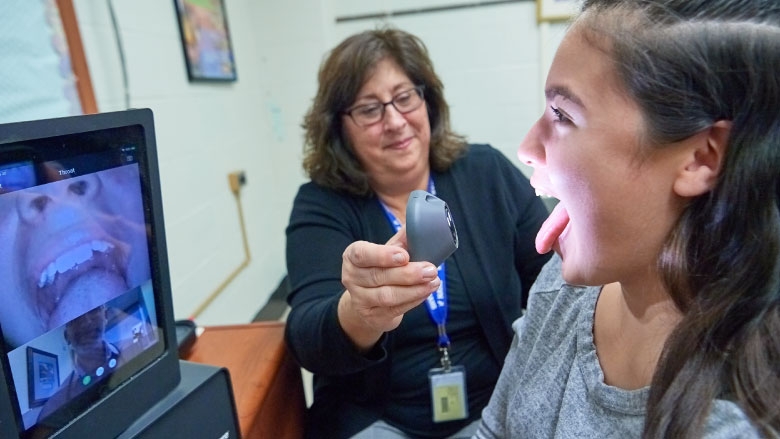Technology Brings the Doctor to School
Published on
Children's ViewPublished on
Children's View Donna Gill, MEd, RN, CSN, the school nurse at Norristown Area High School, examines student Kenya Prado Villalvazo, 17.
Through a new telehealth program, CHOP pediatricians can do virtual exams in schools.
Donna Gill, MEd, RN, CSN, the school nurse at Norristown Area High School, examines student Kenya Prado Villalvazo, 17.
Through a new telehealth program, CHOP pediatricians can do virtual exams in schools.
One of the most important figures in children’s health — the school nurse — has a new partner.
In a pilot program at a local school district, Children’s Hospital of Philadelphia pediatricians are on call each school day for “telehealth” consults with students and school nurses.
An earache. A rash. A headache. If a child comes to the nurse’s office with an ailment that warrants a doctor visit, the visit happens, then and there.
In telehealth, a doctor assesses patients without being physically present. In the school nurse’s office, the nurse, patient and doctor are connected by screen and voice — like a healthcare version of FaceTime or Skype, only much more secure.
The pediatrician, who may work at CHOP’s Main Campus in Philadelphia or at a CHOP primary care practice, connects with the nurse to examine the child, using sophisticated tools adapted for virtual visits. The nurse listens to the child’s lungs, and the doctor hears the audio. The nurse takes video of a rash, and the doctor, in real time, gets a high-quality picture. The nurse looks in the child’s ear, and the otoscope transmits the image to the doctor.
The technology is so advanced, doctors feel more than comfortable making a diagnosis remotely. “I can see the eardrums and the throat even better using this device than I would in person,” says Bonnie Offit, MD, one of the school telehealth pediatricians and a leader of the program. “The images are clear, magnified and well-lit.”

From his office at the hospital in Philadelphia, CHOP pediatrician Philip Scribano, DO, MSCE, viewed images of the exam in real time and evaluated Kenya’s symptoms.
One of the first of its kind in Pennsylvania — if not the first — the telehealth program began last school year at three schools in the Norristown Area School District. This year, it is in all 12 of the district’s schools. CHOP has been delivering educational enrichment days to the district’s nurses for several years, creating a partnership that made Norristown a good choice for the pilot program.
Through telehealth, the doctor makes a diagnosis and decides, with the nurse, whether the child can return to the classroom. Often, they can, so classroom time is preserved and a parent doesn’t have to leave work. In addition, the doctor can e-prescribe medications, saving the family a separate trip to the doctor’s office.
Parents opt their children into the program at the start of the school year and are called before a telehealth visit commences, if they choose that option. There is no charge for the service, and all children are eligible, regardless of insurance status.
“All I had to do on my way home from work was pick up the prescription,” explains Tina Chaaraoui. Her daughter, Kayla, a seventh-grader at East Norriton Middle School, was evaluated via a CHOP telehealth visit for an earache. “It was a big help,” says Chaaraoui. “I was really busy at work — it would have been hard for me to leave. It was late on a Friday afternoon, so getting a doctor’s appointment would have been difficult. Maybe we would have been heading to an urgent care center over the weekend. But this was perfect!”
Over time, school telehealth programs may contribute to academic success and family stability. They can have particular meaning for families with parents who work jobs with inflexible schedules or who work shifts where the emergency room is the only option for care by the time they get home.
The program got off the ground with funding from the United Way of Greater Philadelphia and Southern New Jersey. Expansion was possible thanks to donor gifts that are “unrestricted,” meaning they’re not designated for a specific use and can be drawn upon quickly when promising opportunities arise, like this program. More donor-partners can bring CHOP pediatricians into even more school nurse offices, or help provide care to students whose schools don’t have nurses. CHOP is also investigating telehealth for counseling sessions to help children with their emotional health.
“School telehealth is definitely a growing phenomenon,” says Tracey Haines, a portfolio leader for CHOP’s Digital Health team, which is charged with finding effective ways to use technology to improve healthcare. “Our goal is to expand so that this becomes commonplace. Doesn’t it make sense to provide care to children where they spend most of their day?”
Categories: Children's View Winter 2019